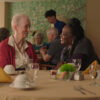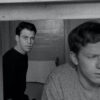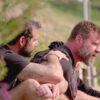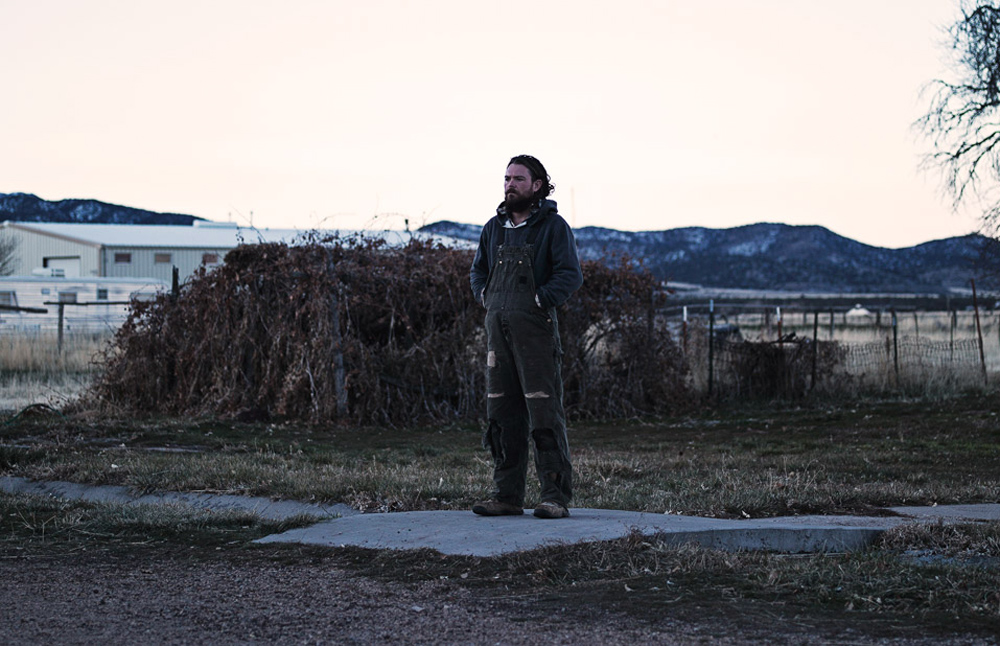“It’s like the time between high school [and now] never happened,” David (Clayne Crawford) can be heard lamenting to his wife Nikki (Sepideh Moafi) during a supposed date night in “The Killing of Two Lovers.” His F-150 is parked right outside from where their three kids are inside playing, but he is no longer necessarily welcome in the home after attempting a trial separation with Nikki that he was less eager for than she was, and while he’s talking about moving back in with his sick father, who still treats him like a teenager, he somehow misses the fact that across from him, he feels as if nothing’s changed since the two were high school sweethearts when clearly one look at Nikki reveals that everything has.
It is just one extraordinary moment among many in the latest film from Robert Machoian, who has had a tendency to create unforgettably tender dramas about family, often mixing in his own to render an undeniable authenticity and depth. Although Machoian’s move to Utah to be an associate professor at BYU brought an end to his long-running collaboration with the Monterey Bay-based filmmaker Rodrigo Ojeda-Beck, with whom he made his first features “God Bless the Child” and “When She Runs,” he brings the same spirit to “The Killing of Two Lovers,” surrounding Crawford with his father Bruce Graham in the role of David’s dad and his sons Arri, Ezra and Jonah (joined by Avery Pizzuto to play David and Nikki’s teen daughter) for the story of a clan that threatens to be torn apart by David and Nikki’s likely impending divorce. Trapped in the small town of Kanosh where the majesty of the mountains can be seen in any direction yet seem so far out of reach for those living on flat land, David’s insistence on hanging on to memories of what his relationship to Nikki when they were 17 threatens to blow things up as much as her decision to begin dating Derek (Chris Coy), whose temper rivals David’s.
Eventually, these frustrations manifest themselves in explosive ways, but “The Killing of Two Lovers” rivetingly stokes the little fires throughout that its characters struggle to put out as a long-time relationship comes to an end, featuring simmering performances from Crawford, Moafi and Coy as a trio that has little to hold onto with so much uncertainty in the air and the inability to feel they can trust the ones they purportedly love with the true feelings that they have. On the eve of the film’s premiere at Sundance, Machoian was gracious enough to speak about maintaining his unusually intimate style on a higher-profile production, finally having the opportunity to work with Crawford, whom he met in Park City a decade earlier, and seeing his kids take an organic interest in filmmaking.
How did this come about?
Clayne and I have been trying to work together since I made “Charlie and the Rabbit.” We both had films at Sundance [that year], and I had written another feature script I really, really wanted him to be involved in and we just couldn’t raise the money. Everyone had said the story was just too sad. [laughs] Then he ended up getting “Rectify” and I ended up making “Forty Years from Yesterday,” so we were paralleling each other and we kept in touch. I kept writing scripts for him and then finally, I was like, “Dude, I’m going to write a script, it’s all one location. We can make it.” And I sent it to him and he’s like, “Yes, definitely” and things aligned.
The film itself was just [inspired by] coming from a family of six and all of my siblings and myself have been married. Some have gotten divorced, some are still married and some have separated and gotten back together, so I was really just taken by this relationship when you commit to each other and how there are beautiful and ugly things that exist within this context.
I’m going to take it back to “When She Runs” a little bit because one of the things I was excited about was this duality where you see the lead character compartmentalizing their pain and frustration, so they’ll show it in private as opposed to public. Is that an ongoing interest?
Yeah, I’m very taken by this idea that we only know so much about [another person]. Even my wife only knows so much about me, right?There’s these multiple lives that people are living and in the case of David, I wanted to address these different aspects of him. Like with his wife [Nikki], he’s not a great person in this period of time, but with his children, he excels. And with Nikki, I was very interested in the growth. My brother and his wife got married when they were 18 years old, and they’re both amazing people, but it’s interesting when you make a commitment that young, people grow in that time and that growth doesn’t always split people, but it does oftentimes throughout your marriage not put you on the same level that you were. For example, I got into films because of my wife. I lived in a small town that had one movie theater and she introduced me to “Gummo” and “Buffalo ’66,” these films that were blowing my mind. Now, it’s like ten years into our marriage and I’m like, “Check out this movie,” and she’s like, “I’m not really into that anymore.” And I’m like, “What?!?” [laughs] No, we’re on the same page. We both love movies. But [on some] she’s like, “Uhnnn…”
One of my favorite lines in the movie is when David’s in the truck talking to Nikki, talking about his father, and tells her “It’s like everything since high school didn’t happen” and you just look at her and realize everything’s changed in their relationship even if he feels like he’s in the same place.
Yeah, it was important to me that he’s rooted in that location – he’s rooted in that life and he’s actually really happy with it. You’ll notice all his colors are earthtones. And the dichotomy in that car is exactly what’s happening, which is he wants it to be as if nothing’s changed from high school whereas Nikki’s really growing and she’s not necessarily interested in growing apart, but there are periods of time where you almost need this ability to make mistakes and fail and understand better who you are as a person. That’s really what I wanted to explore with [Nikki].
It sounds like you knew Clayne quite well, but I know in your past films your main actors lived their experiences to a degree – did you have to change your approach here?
Yeah, most of the time, I’m working with either family members or Kristen [Anderson], for example in “When She Runs,” was a PA on “God Bless the Child” so it was me and Rodrigo [Ojeda-Beck] and her just shooting this movie and she was so great and she’s like, “Oh, I like to act,” so we were like, “Do you want to make a movie?” and we structured this movie around her, knowing that she’d be the lead.
I had been writing stuff with Clayne in mind, and we knew each other through the fact that we’d talk to each other on the phone, but here I am dealing with non-actors most of the time and all of a sudden, I get this amazing opportunity to work with Clayne and Sepi and Chris. I don’t know if they’ve ever worked on a set that small in their career, like where it’s like me and Oscar and I have four other students and that’s it. [laughs] That environment was what I was comfortable with, but it took a lot of trust and faith on their end, so that was new for me.
Is it true it was your kids who encouraged you to write another film for them to be in?
Yeah, my three little ones were really interested in acting and as a parent, you have to ride this really fine line of am I doing this because I want to as a filmmaker or are they really wanting to? They kept bugging me, so we made [the short] “The Minors,” [which] was motivated by them pushing me, saying “Come on, we want to be in something.” Then when I started to write this film, I had them in mind because they had just done such a great job in “The Minors” and they were very serious. On “The Minors,” I had this epiphany because I’d be setting up camera stuff with Oscar and [the kids] would be over there talking, and they’d be like, “Well, he’s going to do this and I’m going to do that, and then we’re going to do that,” and I’m like, “You guys are working out your beats.” It was the first time where I’m like, “Okay, you’re actually very serious about your craft.” So when we were doing the feature, I just knew they’d be perfect because I wanted David to have these kids and I wanted the audience to understand these kids are being raised in a healthy environment, but we’re just entering [it for a rough patch].
Was it interesting having the interaction between your family and these actors?
I was really, really interested to see how it works because Clayne, Sepi and Chris are dealing with such big shows and I’m like here we’ve got this little story and my dad’s in it, my kids are going to be in it and “Are you guys okay with that?” But it was so funny because the very first day that Sepi arrived on set, I pulled [my son] Jonah aside and said, “She’s going to play your mom.” And he’s like, “Okay,” and then he just climbed up in her lap and he laid with her and he actually ended up falling asleep in her arms. I was like, “Oh my gosh, this is going to work.” They fused together so quickly as a family and it was really exciting to see how open the kids were to considering Clayne and Sepi their parents, which was really, really exciting because with “God Bless the Child,” one of the things that was so important to me about casting my kids was just how they [physically] touched each other. They were so comfortable laying and rolling and pushing on each other and it was that kind of loving relationship that I didn’t really know if it could transfer over. Shooting this film and seeing the boys just really embrace both of them as their parents was really exciting.
I remember how much you could work those scenes in “God Bless the Child,” spending weeks on something since it was your kids in your house. Could you bring that here with less time to work?
Yeah, Chris and Sepi and Clayne had very tight schedules. We shot the film in about 14 days total, and what was exciting for me is that the three of them are really open to the same workflow I had done with “When She Runs” and “God Bless the Child,” which is I want them to understand the nature of the scene, I want them to understand their lines so that the writing’s there, but I want them to bring the movement. That’s partly why I try to shoot as much as I can wider or handheld to allow us or the actors or the camera to respond. In the argument scene in “The Killing of Two Lovers,” that’s just Oscar and me on a golf cart, and as I’m feeling the elevation of tension or hardship or heartache, I’m just wheeling this golf cart in and as Oscar’s panning to make sure that he’s getting the framing he’s wanting and then I’m backing out. They were open to the dance or performance, which is just so critical because we could’ve done these scenes 50 different ways and because of that option, I didn’t want to remove the workflow that I had learned through other films.
One of the most interesting elements of the film becomes how the characters are seen relating to the environment through how you frame them. What was it like figuring out how to portray that visually?
Interestingly enough, Chris is from Kentucky and Clayne’s from Alabama and they’re both from smaller towns, so they understood the environment of that small-town living, and Sepi and Chris came in two days early so they could live in the environment and spent time with the locals. What was so critical about Kanosh as a location in and of itself was the fact at almost every angle, you could see the mountains, and I really wanted to address this interesting aspect of the outsider/interior perspective of marriage. Sometimes on the outside, things look beautiful and fine and you’re somewhat envious and then you go in a little bit closer and you can see it’s more complicated than what you thought.
The score seemed to echo that to me with distant sounds that could become intense – how did that come into play?
I’ve never used a traditional musical score, partly out of not having access to people that have access to an orchestra, but the other aspect is that we’ve normally dealt with sounds within the world. We worked with Peter Albrechtsen, who Rodrigo and I worked with on “When She Runs” – and we used the train sounds, which was pretty consistently the metaphor in that film for [main character, a runner], the steam engine just trying to constantly push forward, and I really liked that, but in that film, it’s almost like in the background and it becomes a question of whether it’s really the inside of her head or whether it’s outside. In this film, I just wanted to push that so much harder. Since a lot of David’s psychology is very unstable, I wanted him to be unstable, but I didn’t want to abandon the sounds of that area, so there’s doors slamming. There’s trees twisting. And Peter ended up using in many ways sounds and elements that exist within that environment, but it’s a lot more overt than it was in “When She Runs.”
What’s it like to be headed to Sundance with a feature?
It’s unreal. One of the things that’s interesting for me is that it’s 10 years almost to the day that “Charlie and the Rabbit” premiered at Sundance, and I just remember being at Sundance [thinking] this is such an amazing audience, I want to be back here with a feature, and then meeting Clayne shortly after that. So it’s really poetic to have this drive to eventually have a film at Sundance and this drive to work with Clayne and both those things came together. I’ve been basking in how exciting it is to put in 10 years of work into arriving at a place and then finally arriving there.
“The Killing of Two Lovers” will screen at the Sundance Film Festival on January 28th at 6 pm at the Temple Theatre in Park City, January 30th at 3:30 pm at the Redstone Cinema 1 in Park City, January 31st at 8:30 am at the Prospector Square Theatre in Park City and February 1st at 12:30 pm at the Rose Wagner Center in Salt Lake City.




